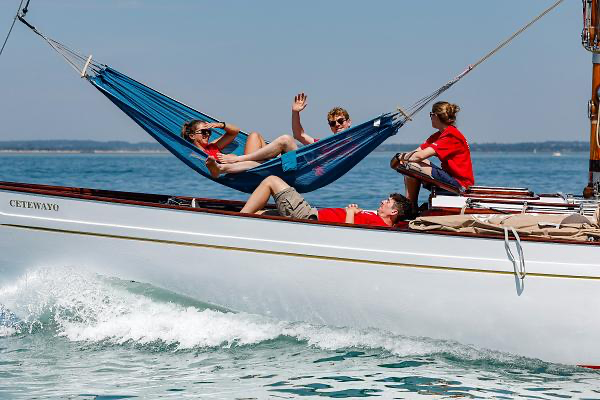Today dawned bright and sunny with a northerly breeze that faded during the morning as the land heated up, but a stable sea breeze failed to materialise, forcing racing for all classes to be abandoned.
The short series for both J/70s and SB20s that took place over the first four days of the Regatta has now concluded, with nine of the 12 scheduled races completed.
In the J/70 class 40 per cent of competitors in the 30-strong fleet achieved at least one top five finish. However, Martin Dent’s Jelvis posted an impressively consistent series of results with a near perfect scoreline, counting seven first places and one second. He therefore wins the series with nine points.
William Edwards & Ian Dobson’s Sardonyx and Simon Pattison’s Standfast were the only other boats to take a race win. Sardonyx took second place overall on 26 points and Standfast third on 29.
Nico Razmilovic’s Glasgow Kiss scored a similarly emphatic victory in the SB20 Grand Slam. Having been scored OCS in the opening race, he went on to win six races and take second place in the other two, finishing the series on 10 points. Charles Whelan and Richard McAdam’s Breaking Bod were second with 20 points and Simon Berry’s Betty third on 22 points.
Today was also Women’s Day at Cowes Week which celebrates the achievements of the many female sailors in the sport. Over the first three days of racing women helms have already notched up five race wins and a total of more than 20 podium finishes.
The Portsmouth based Victory class, which is celebrating its 90th anniversary this year, has multiple women helms who participate in racing through the season, while Marie-Claire Sothcott is helming her family boat Unity all week at Cowes for the third time.
“The Victory class is really welcoming and I appreciate Cowes Week noticing females on the water, particularly those who take the helm,” she says. “We’re brave enough and good enough to keep the guys on their toes on the start line. It’s also good to recognise some really talented female crew as well, which the Victory class has in abundance.
“The Solent is a really unique place to race,” she continues. “Those who regularly come first when we’re racing in Portsmouth don’t necessarily come first here at Cowes. The tides are a challenge and really understanding where the wind’s going to be, where the tide’s going to be and where the marks are is a race in itself. You can’t compare it to any other racing in the world.”
In a class in which the top five boats regularly finish within a few seconds of each other, she adds: “the more you practice, the luckier you get, and certainly in our wooden boats it’s about keeping the boat rolling and understanding those tides.”
At the end of today competitors and spectators alike will be treated to the spectacle of the giant aircraft carrier HMS Queen Elizabeth sailing past Cowes and turning around in the central Solent. She will then hold off for a ceremonial and salute exchange with the Royal Yacht Squadron.
The 284-metre long ship is scheduled to approach from the east, passing Prince Consort buoy north of Cowes at 1815, before turning around with the aid of tugs. She will hold off from around 1830 to 1850 for the salute, before heading back east to dock in Portsmouth Harbour.
Cowes Week racing continues on Wednesday, when we will also highlight the participation of the many young sailors at the Regatta.
Video Highlights of this week’s racing
Facebook: https://www.facebook.com/cowesweek
Instagram: https://www.instagram.com/cowes_week/

